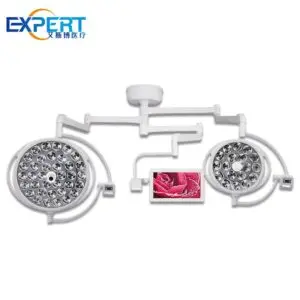Indirizzo
304 Il cardinale nord S.
Dorchester Center, MA 02124
Ore di lavoro
Dal lunedì al venerdì: 7:00 - 19:00
Fine settimana: 10:00 - 17:00
Benvenuti nel mio blog!
Prima di immergerci nei contenuti, mi piacerebbe che ti unissi a me sulle mie piattaforme social, dove condivido altre intuizioni, interagisco con la community e pubblico aggiornamenti. Ecco come puoi metterti in contatto con me:
Facebook:https://www.facebook.com/profile.php?id=100071234835011
LinkedIn:https://www.linkedin.com/company/74943205/admin/dashboard/
YouTube:www.youtube.com/@shandongexpertmedicalequip4695
TikTok:www.tiktok.com/@expertmedical
Ora, iniziamo il nostro viaggio insieme. Spero che tu trovi il contenuto qui perspicace, coinvolgente e prezioso.

Surgical procedures demand precision and clarity, and the quality of lighting plays a pivotal role in achieving these objectives. Traditional lighting sources, such as incandescent and fluorescent lamps, have long been used in operating rooms. However, these sources often fall short in providing the optimal illumination required for complex surgical procedures. In recent years, LED surgical ceiling lights have emerged as a superior alternative, offering numerous advantages over traditional lighting solutions.
One of the most critical factors in surgical lighting is the ability to accurately visualize tissue color and texture. The Color Rendering Index (CRI) measures a light source’s ability to render colors accurately. LED surgical ceiling lights typically boast a high CRI, often exceeding 90. This means that they can accurately represent the true colors of tissues, blood vessels, and surgical instruments, allowing surgeons to make precise incisions and identify subtle changes in tissue appearance.


Traditional lighting sources, particularly incandescent and halogen lamps, generate significant heat. This excessive heat can be uncomfortable for both patients and surgical staff, and may even damage delicate tissues. LED surgical ceiling lights, on the other hand, emit minimal heat, creating a cooler and more comfortable operating environment. This reduced heat emission is particularly beneficial during long and complex surgical procedures, as it helps to minimize patient discomfort and fatigue.
LED surgical ceiling lights are renowned for their exceptional longevity. Compared to traditional lighting sources, which have relatively short lifespans, LEDs can last up to 50,000 hours or more. This significantly reduces the frequency of bulb replacements and associated maintenance costs. By minimizing downtime for maintenance, hospitals can maintain a consistent and reliable lighting environment in their operating rooms.
LED surgical ceiling lights offer instant-on capabilities, eliminating the warm-up time required by traditional lamps. This allows surgeons to quickly adjust the lighting conditions to suit the specific needs of each procedure. Additionally, LED surgical ceiling lights can be easily dimmed to achieve the desired level of illumination, reducing eye strain and fatigue for both surgeons and surgical staff.









LED surgical ceiling lights are highly energy-efficient, consuming significantly less power than traditional lighting sources. This translates to lower energy costs and a reduced carbon footprint. Furthermore, LEDs do not contain harmful substances like mercury, making them a more environmentally friendly choice. By adopting LED surgical ceiling lights, healthcare facilities can contribute to a more sustainable future.
LED surgical ceiling lights offer a high degree of flexibility in terms of light distribution. They can be designed with various light distribution patterns, such as focused, diffused, or a combination of both, to meet the specific requirements of different surgical procedures. This customizable lighting allows surgeons to achieve optimal illumination in the surgical field, reducing shadow formation and improving visibility.

| Caratteristica | LED Surgical Ceiling Lights | Traditional Surgical Ceiling Lights |
|---|---|---|
| Indice di resa cromatica (CRI) | High (typically 90 or above) | Inferiore |
| Emissione di calore | Minimo | Alto |
| Durata | Long (up to 50,000 hours) | Short (several thousand hours) |
| Efficienza energetica | Alto | Basso |
| Instant On/Off | SÌ | No (warm-up time required) |
| Capacità di oscuramento | SÌ | Limitato |
| Impatto ambientale | Basso | Alto |
LED surgical ceiling lights have revolutionized the operating room by providing superior lighting quality, energy efficiency, and durability. Their ability to accurately render colors, minimize heat emission, and offer customizable light distribution has made them the preferred choice for modern surgical facilities. As LED technology continues to advance, we can expect even more innovative and efficient lighting solutions to emerge, further enhancing the safety and effectiveness of surgical procedures.
What is the color temperature of LED surgical ceiling lights?
The color temperature of LED surgical ceiling lights is typically between 4000K and 5000K, providing a neutral white light that is ideal for surgical procedures. This color temperature offers excellent color rendition and reduces eye strain.
Are LED surgical ceiling lights dimmable?
Yes, most LED surgical ceiling lights are dimmable, allowing surgeons to adjust the light intensity to suit the specific needs of each procedure. Dimming capabilities are essential for minimizing glare and creating a comfortable operating environment.
Quanto spesso LED surgical ceiling lights need to be replaced?
LED surgical ceiling lights have a very long lifespan, typically lasting up to 50,000 hours or more. This significantly reduces the frequency of bulb replacements and associated maintenance costs.
Are LED surgical ceiling lights more expensive than traditional lighting sources?
While the initial investment for LED surgical ceiling lights may be higher, the long-term savings in energy costs and reduced maintenance make them a cost-effective choice. Additionally, the improved patient outcomes and increased efficiency associated with LED lighting can further justify the initial investment.
